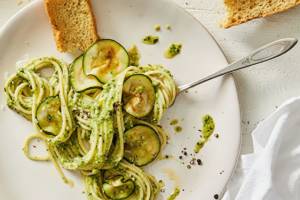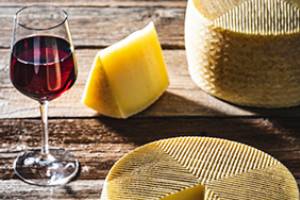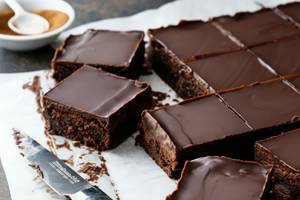
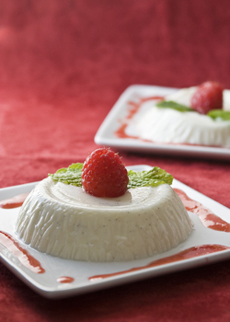
A classic panna cotta. Photo by Rafa Saidi Granados | The Nibble.
September 2006
Last Updated May 2025
|
 |
Custard Glossary: All Types Of Custard
Page 4: Terms & Definitions: G ~ P
Discover all types of custard. This page includes terms such as mousse, mousseline, panna cotta and pot de crème.
Use this index bar to visit other glossary sections.
a b c d e f g h i j k l m n o p q r s t u v w x y z
This glossary is protected by copyright and cannot be reproduced in whole or part.
You are welcome to link to it.
GELATIN
A clear, odorless, and flavorless setting agent derived from animal bones. It is used to set cold desserts such as mousses and Bavarian creams. Strict vegetarians and kosher people who do not consume any animal products use vegetable setting agents, including one made from agar agar, an algae.
MACAROON CUSTARD
A half cup of macaroon crumbs is folded into the custard prior to baking.
MOUSSE
A French term meaning “froth” or “foam,” mousse is a rich, airy custard made of whipped cream, eggs, and gelatin that can be either sweet or savory and hot or cold. Cold dessert mousses are usually made with fruit purée, a spice (vanilla, almond), or other flavoring such as chocolate. A mousse is light and airy due to the addition of whipped egg whites, whipped cream, or both. Fruit mousses are usually fortified with gelatin. Mousses are too soft to mold into a semi-rigid form, so they are usually piped or scooped into the final dessert presentation and garnished with additional whipped cream prior to serving.
Savory mousses can be made from meat (ham, chicken, veal, e.g.), fish, shellfish, foie gras, cheese, or vegetables. Hot mousses usually get their light texture from the addition of beaten egg whites. They’re generally baked in a bain-marie to prevent the mixture from curdling.
|
|
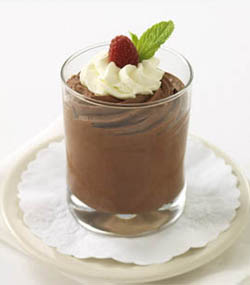 Chocolate mousse. Photo courtesy
Chocolate mousse. Photo courtesy
Morton’s The Steakhouse. |
MOUSSELINE
In savory cooking, a mousseline is a sauce made by folding unsweetened whipped cream into a hollandaise. In sweet dishes, it refers to a buttercream lightened with crème pâtissière that is used as a filling for cakes and pastries.
OEUFS À LA NEIGE
Translation: eggs in snow. See floating island.
PASTRY CREME
See crème pâtissière. This is the form of custard used to fill cream puffs and éclairs.
PANNA COTTA
Italian for “cooked cream,” it is a light, silky-smooth egg custard made with heavy cream and gelatin and typically served with fresh fruit or a fruit purée. Panna cotta originated in the Piedmont area of northern Italy, a region known for its cream.
|
|
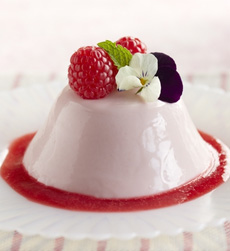
Panna cotta. Photo courtesy Driscoll’s. |
POSSET
A posset is a type of British custard that sets without eggs. Instead, it relies on an acid, like lemon juice, to thicken it. Like egg custard, it’s made from cream and sugar, but not surprisingly, it lacks the eggy flavor. Like custard and other puddings, it’s creamy and spoonable. Panna cotta, an Italian custard made without eggs, is set with gelatin instead of lemon juice. The result is that panna cotta is firm, smooth, and jiggly.
Unlike like panna cotta and France’s crème caramel and Spain’s flan, it is soft like pudding cannot be unmolded.
|
|
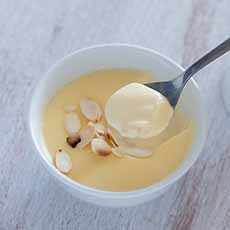
Lemon posset (photo by Jules Stonesoup CC 2.0 License).
|
Originally, posset was a hot drink, often spiced and sweetened, and made by curdling milk with wine or ale. It was used as a remedy for colds, fevers, and insomnia in medieval and Renaissance England. It gradually fell out of use as a drink and re-emerged in 20th-century Britain as a chilled dessert: a sweetened cream thickened by the curdling action of citrus juice.
POT DE CRÈME
Pronounced poe-duh-CREHM and French for “cup of cream,” it is an eggy, soft, and smooth custard made of equal parts of cream and milk and an extensive amount of egg yolk—e.g., 6 yolks per 2 cups of cream/milk (or half and half). It is traditionally served unadorned, except perhaps with a decorative candied violet, in a small, lidded porcelain cup (the “pot”). The porcelain pots can be plain white or colored ceramic, or they can be ornately decorated fine porcelain. Pots can be single- or dual-handled. Note that while pot de crème can look like mousse to the untrained eye, pot de crème is a dense pudding while mousse is whipped and airy.
|
|
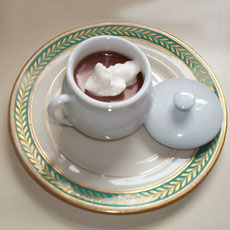
Pot de crème. Photo courtesy Seduction Meals.
|
Continue To Page 5: Terms With Q ~ Z
Go To The Article Index Above
|
